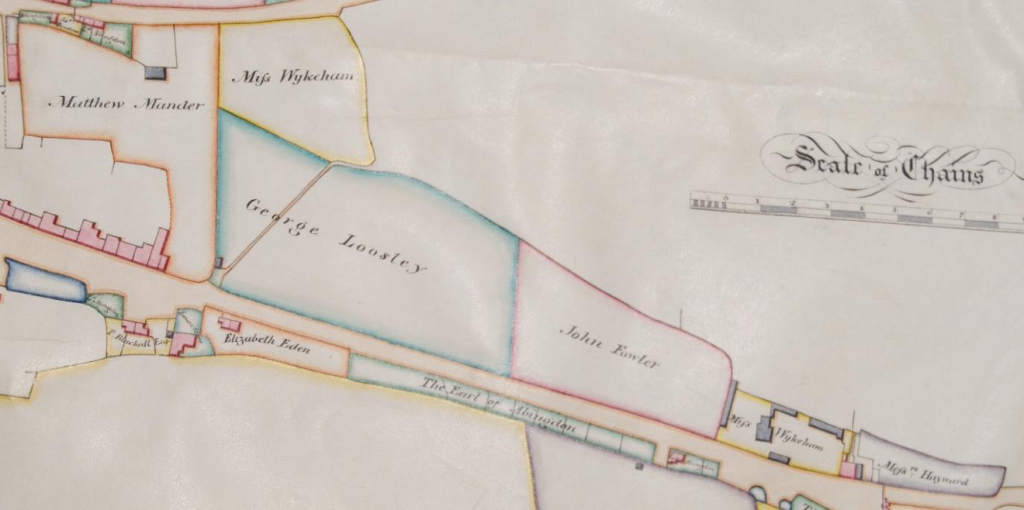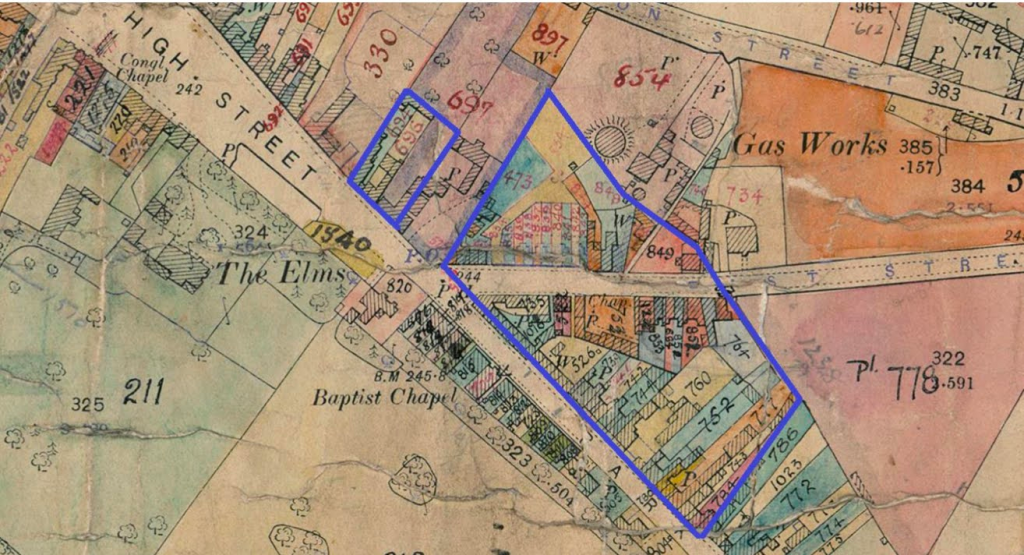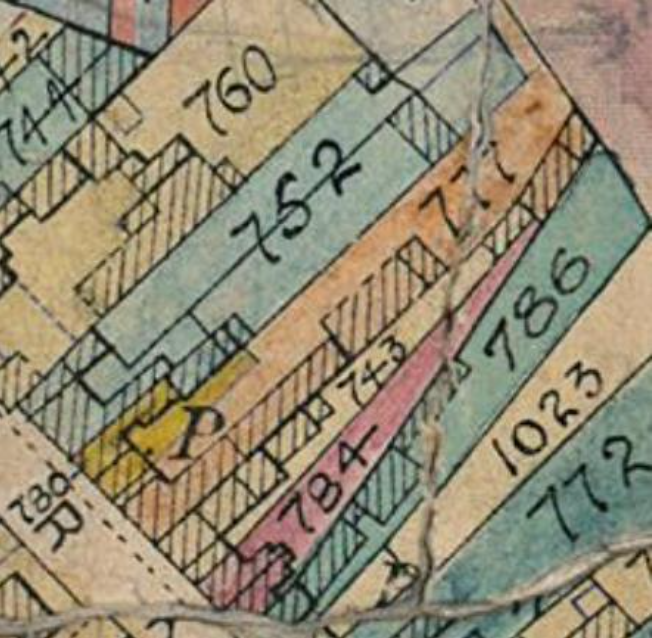The History of Whitehound Close
The following is an interpretation of the documents in bundle T2011_18.
A printable copy of the interpretation can be found here
A transcription of the document can be found here
The purpose of the original document was to allow George Loosley, a Thame yeoman farmer of Priestend, to sell a plot of enclosed land he had inherited from his mother. The plot in question lay to the east of Thame High Street.
The document is a legal instrument called an Abstract of Title. This is a common form of legal document, listing and describing previous documents, typically property deeds and wills, which show that someone is the rightful owner of the property in question.
The enclosed land inherited by George Loosley was known by the name of Whitehound Close, or White Hound Close. It is named after an ancient inn that once stood opposite what is now the Memorial Gardens, which are on the site of what was once White Hound Pond, in turn named after the inn that stood opposite.
In 1826 the Thame Enclosure Award Map confirmed George Loosely as the owner of White Hound Close, as shown below:

We don’t know exactly where the White Hound Inn stood. It is said to have burnt down in the seventeenth century, and may have been a large galleried Inn.
In 2010 a District Valuation Map of Thame was produced. Below is a section of the map showing the outline of White Hound Close as per the 1826 map above (with a little guesswork), and a conjectured footprint of the White Hound Inn also shown:

We can see here what happened to White Hound Close after George Loosley sold it off, it being divided into a number of different building plots.
Obvious also is what is now East Street running through the close, in large part dictating the size and shape of the building plots.
By 1830, the Thame to Princes Risborough Turnpike Road had been completed. It ran from Thame High Street, along what is now East Street (at first known as New Road) through Kingsey and Longwick to Princes Risborough.
The Shakespeare Connection
In the summer of 1587, Queen Elizabeth’s Men, a troupe of travelling performers, were staying at Thame. It seems they had been performing at the White Hound Inn, or perhaps in the open air in White Hound Close.
A fight broke out between two members of the troupe, William Knell and John Towne. William Knell entered White Hound Close, where he attacked John Towne with his sword. Attempting to flee, Towne climbed a mound outside the close and thrust his own sword into Knell, fatally wounding him. A coroner’s inquest was then held at Thame, finding that Towne had acted in self-defence. Queen Elizabeth later pardoned him.
The speculation is that the troupe later arrived in Stratford upon Avon, short of an actor, and a young William Shakespeare joined them, launching his career. This story may be a little speculative but it gives a flavour of life in Tudor Thame. Across the road from White Hound Inn stood a fine merchant’s house where some years before a set of Tudor paintings was installed, now to be seen in Thame Museum.
A Long Tail
The chain of ownership of White Hound Close disclosed in the document begins with the Rice family of Waddesdon. The story however begins earlier, in Thame in the seventeenth century. White Hound Inn had it seems burnt down, although the close attached to it kept its name. Ownership of the close had transferred to the owner of a different inn.
What is now no 2 Buttermarket was then the Bull Inn, run by Stephen Cousen, who made his will in 1654, leaving White Hound Close to his married daughter Elizabeth Brookes. The close is described as “one close of pasture ground called by the name of Whitehound with appurtenances sett and being in Old Thame”.
The term Old Thame comes about because the medieval planned town, which is basically Thame High Street, became known as New Thame, and the wider land around it as Old Thame. White Hound Close was an ancient enclosure, but it lay outside the planned town, in Old Thame.
The will of Stephen Cousen stipulated that White Hound Close could only pass down though the female line. This is an example of what is known as a tail, or entail, in legal terms. Elizabeth Brooks had a daughter, Anne, born in 1675, who must have inherited the close. Anne Brooks married a member of the Rice family of Waddesdon. What seems to be happening is that William Rice Junior is claiming ownership of the close, so that he can sell it.
A legal device called an Exemplification of Common Recovery is being performed, with the help of several people, the purpose of which is to remove the entail. The end result is that William Rice Junior sells the close to widow Ann Betteridge of Thame for £145, in October 1706.
In 1749 Ann Betteridge wrote her will, leaving White Hound Close to her kinswoman Ann Turner. At this time, the close is described as “All that her Closes of Arable Land then used for a Garden lying and being in Old Thame in said County of Oxford called or known by the name of White Hound Close then in the occupation of David Bristow the elder”. Ann Betteridge it would appear changed the use of the land from pasture to cultivation.
As stipulated in the will of Ann Betteridge, the close later passed to William Turner of Blizworth who sold it to Thame yeoman Richard Higgins, of Priestend, from whom it passed to his widow Ann Higgins, in 1794. Ann Higgins was the aunt of Sarah Loosley, also of Priestend, to whom she bequeathed White Hound Close.
Sarah Loosley died in 1814, and the close passed to her son George, whose ownership of White Hound Close is now proved.
What Happened Next?
George Loosley proved his title to White Hound Close in 1833, three years after the turnpike road had been driven through the close. He then set about selling parts of the close, the two principal buyers it would seem being local grocer and leading Quaker William Wheeler, who around the same time was instrumental in establishing the Royal British School in Park Street (now John Hampden School) and local builder James Bonner, who built himself a house in East Street.
Park street at this time was called Brick Kiln Lane, named after the brick kiln at the end of it. Between the town and the brick kiln around 1830 there was open land, not built up. Between White Hound Close and the brick kiln was another enclosure, opposite the grounds of the Royal British School, shown in the 1826 Enclosure map above as belonging to a John Fowler. This was evidently sold at some time, and turned into building plots, as Brick Kiln Lane became known as Park Street and a new community began to grow to the east of Thame.
The number of households in Park Street in each of the census returns from 1841 to 1891 shows a step-change in 1871, indicating that the second enclosure was sold or developed in the 1860s. The chapel in Park Street bears the date 1865. This may have been around the time Park Street, and East Street, were made up as streets, with pavements and drains.
While there may be a long row of buildings lining the north side of Park Street today, behind them the dividing line between George Loosley’s enclosure and John Fowler’s enclosure is still there to be seen. The boundary of White Hound Close is at a different angle from the building plots ranging off Park Street. In the map from 1910 below the pink plot number 784 is in White Hound Close and the blue plot number 786 is in John Fowler’s enclosure.

Looking at the 1826 map, we see two narrow strips lying to the south of Park Street, one belonging to Elizabeth Eden and one to the Earl of Abingdon, the then Lord of the Manor of Thame.
In his book “Making the Road from Princes Risborough to Thame”, Peter Gulland points to a similar roadside plot owned by the Earl of Abingdon in Wellington Street and tells us that such plots were “vegetable gardens on the highway verge”. (In a time of horse-drawn transport this would not have been as bad an idea as it might seem today.)
The plot belonging to Elizabeth Eden along Park Street may have been used in the same way. Looking at the buildings on the southern side of Park Street, we see that Elizabeth Eden’s plot was developed into a row of residences or premises, up to around number 87, which is the limit of Eden’s land, while those further along, formerly on the Earl of Abingdon’s land, were developed differently.
Someone travelling from White Hound Pond (now the Memorial gardens) in the 1820s, down Brick Kiln Lane (now Park Street), would have seen to the left White Hound Close, a large vegetable garden perhaps, to the right vegetable gardens. In the distance, smoke would be rising silently from the brick kiln.
Two or three generations later, in mid Victorian times, a new community, with an identity of its own, would have grown up. A Nonconformist chapel in both East Street and Park Street, a Nonconformist Royal British School. Rows of cottages housing Thame’s increasing population.






